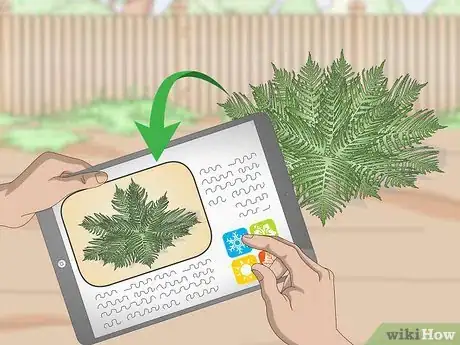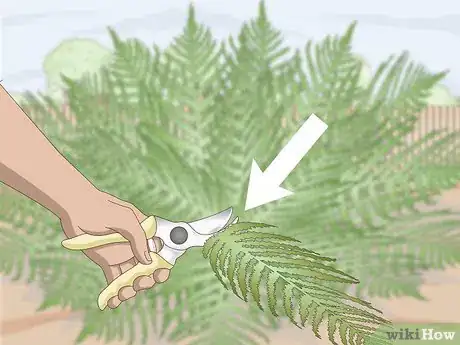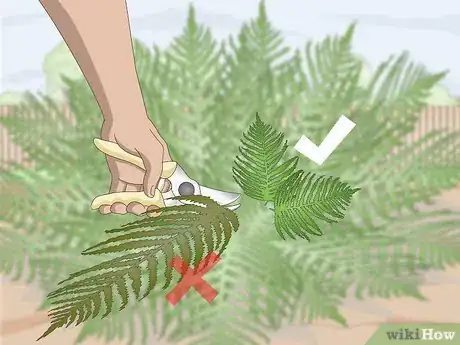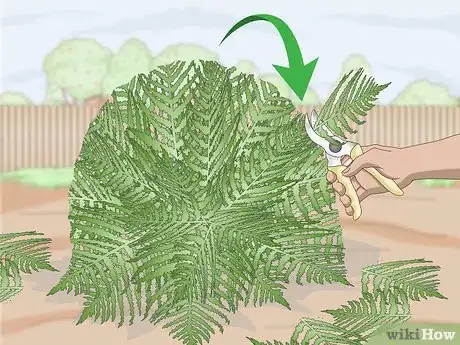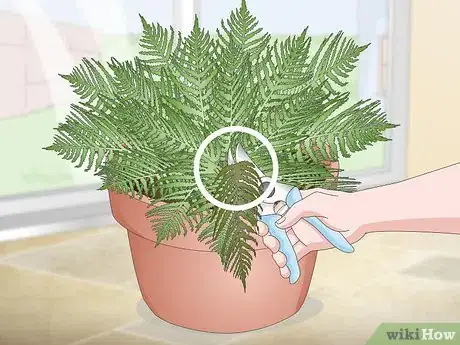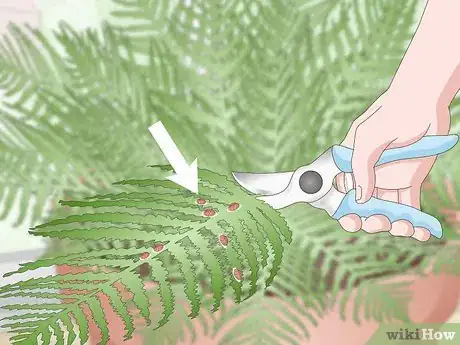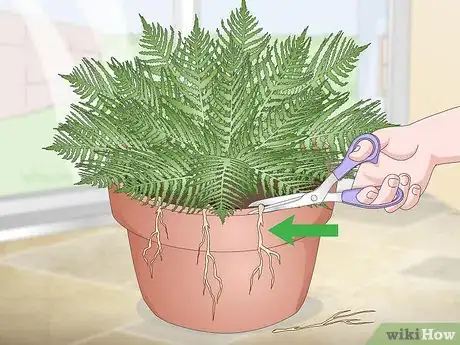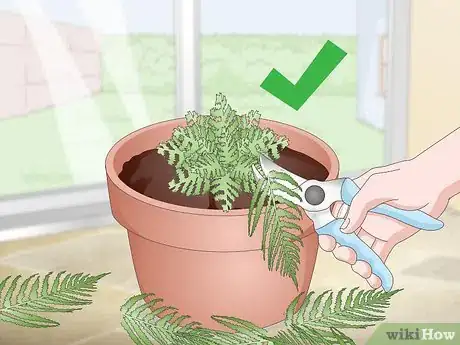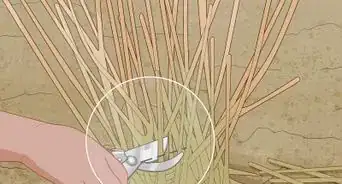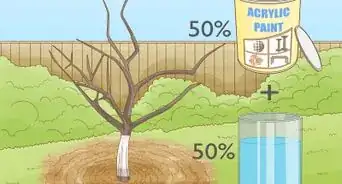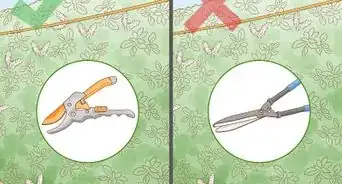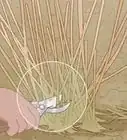This article was co-authored by Lauren Kurtz. Lauren Kurtz is a Naturalist and Horticultural Specialist. Lauren has worked for Aurora, Colorado managing the Water-Wise Garden at Aurora Municipal Center for the Water Conservation Department. She earned a BA in Environmental and Sustainability Studies from Western Michigan University in 2014.
There are 12 references cited in this article, which can be found at the bottom of the page.
wikiHow marks an article as reader-approved once it receives enough positive feedback. In this case, 91% of readers who voted found the article helpful, earning it our reader-approved status.
This article has been viewed 188,955 times.
Ferns are relatively easy to prune. You can prune them in early spring before the new growth begins, or even when the new growth comes in. If you want to create a shape, you can trim around the edges of the plant. When growing ferns indoors, just be sure to cut off dead or dried fronds when they appear.
Steps
Pruning Ferns Outdoors
-
1Check the pruning information for your specific plant. Some ferns, such as the Giant Chain Fern, do not do well with spring pruning. It's best to let the old foliage die out by itself in mid-summer. If you don't, you can cause damage to the plant.[1]
- Once the fronds die, you can cut them out.
-
2Cut back the old foliage early in the spring to make pruning easier. It's easiest to cut back the fern in the spring before the new leaves emerge. You should be able to see the tightly rolled fiddleheads, also known as crosiers, in a crown on the plant. Cut the foliage just above the crown with a sharp pair of gardening shears.[2]
- The old foliage will likely not look as pretty as new foliage in the height of summer.
Advertisement -
3Trim the dead branches after the new growth comes in. Alternatively, you can wait until the new growth comes in to cut off the old fronds. It's best to do this early in the season. Shear off the dead fronds near the crown to make your plant healthier and prettier.[3]
- You can also cut out any older fronds that aren't dead yet but look a little bedraggled.
-
4Cut the outer edges of the fronds to create a desired shape. If you don't like the way your fern is shaped, simply trim the outer edges until it's to your liking. Use sharp scissors or kitchen shears to do the trimming.[4]
- It's best to only trim the outer edges after you've removed yellowing or dead fronds.
- Keep in mind that the tips turn brown if you clip off the edges.
-
5Trim a transplanted fern by half to help it thrive. When you move a fern, it may need some help getting settled in its new location. Cut back all the fronds by half, reducing the water your fern needs to support itself.[5]
- This technique lets the plant focus more attention on getting its roots settled.
- Don't worry. Once the plant is settled, it will grow back.
-
6Avoid pruning right before winter. It can be tempting to cut off dead or dying fronds at the beginning of winter. However, those fronds help protect the root crown throughout the winter.[6]
- In other words, leaving the old fronds in place can help your fern survive through the cold of winter and return in the spring.
Trimming Indoor Ferns
-
1Cut off dead fronds as they appear. Use a sharp pair of scissors to cut the fronds. Dead fronds will be brown or black. Cut them near the base of the frond, just above the joint. You can use a sharp pair of scissors or a small pair of garden shears.[7]
-
2Remove any fronds infected with scales.[8] Scales are tiny insects that attack your plants. They are small, reddish brown, and flat.[9]
- When scales attack the plant, the leaves will likely turn yellow and may weaken. Look for scales on the underside of leaves along the vein or on the stems.
- Scales can spread, so remove any fronds you see with shears or scissors. If you have a bad infestation, you may need to throw out the houseplant so the scales don't spread to other houseplants.
- Outdoor ferns also get scales, but you should try controlling them with oil-based spray pesticides instead of pruning.
- Don't mistake sori for scales. Sori (singular: sorus) contain the spore-producing structures and are located on the undersides of many fern leaves. They appear orange or brown and approximately circular in shape. Although humans may mistake them for pests or disease, sori function as part of a fern's reproductive process and are not a problem.[10]
-
3Chop the root runners that hang over the side of the pot. Some ferns will get "runners," sort of like a strawberry plant, except these are part of the plant's root system. These will be brown and woody. Chop them near the soil in the pot with shears or scissors to increase the health of your plant.[11]
- These runners are draining energy from your plant. By cutting them, you're letting your plant focus on other vital areas.
-
4Cut back to the base if desired. If you are not liking the look of your plant at all, you can cut it down to just above the crown, much as you do with an outdoor fern. Use sharp, clean scissors to cut off the fronds.[12]
- The fern will grow back from the crown, if you let it remain.
Community Q&A
Did you know you can get answers researched by wikiHow Staff?
Unlock staff-researched answers by supporting wikiHow
-
QuestionShould ferns be cut back?
 wikiHow Staff EditorThis answer was written by one of our trained team of researchers who validated it for accuracy and comprehensiveness.
wikiHow Staff EditorThis answer was written by one of our trained team of researchers who validated it for accuracy and comprehensiveness.
Staff Answer wikiHow Staff EditorStaff Answer
wikiHow Staff EditorStaff Answer -
QuestionDo ferns like coffee grounds?
 wikiHow Staff EditorThis answer was written by one of our trained team of researchers who validated it for accuracy and comprehensiveness.
wikiHow Staff EditorThis answer was written by one of our trained team of researchers who validated it for accuracy and comprehensiveness.
Staff Answer wikiHow Staff EditorStaff Answer
wikiHow Staff EditorStaff Answer -
QuestionWhy are my outdoor ferns turning brown?
 wikiHow Staff EditorThis answer was written by one of our trained team of researchers who validated it for accuracy and comprehensiveness.
wikiHow Staff EditorThis answer was written by one of our trained team of researchers who validated it for accuracy and comprehensiveness.
Staff Answer wikiHow Staff EditorStaff Answer
wikiHow Staff EditorStaff Answer
Things You'll Need
- Shears
- Sharp scissors, optional
- Gloves, optional
References
- ↑ https://www.seattletimes.com/pacific-nw-magazine/dont-dally-much-longer-before-pruning-these-perennials-and-summer-flowering-shrubs/
- ↑ https://www.seattletimes.com/pacific-nw-magazine/dont-dally-much-longer-before-pruning-these-perennials-and-summer-flowering-shrubs/
- ↑ https://depts.washington.edu/hortlib/resources/resource_search.php?term=429
- ↑ https://www.gardeningknowhow.com/houseplants/boston-fern/trimming-boston-ferns.htm
- ↑ https://www.gardeningknowhow.com/ornamental/foliage/ferns/transplanting-ferns.htm
- ↑ https://depts.washington.edu/hortlib/resources/resource_search.php?term=429
- ↑ https://www.homeimprovementpages.com.au/article/plant_guide_maidenhair_ferns
- ↑ http://www.uvm.edu/pss/ppp/articles/fernsin.html
- ↑ http://www.guide-to-houseplants.com/scale-insects.html
About This Article
To prune your outdoor ferns, use gardening shears to cut back the old foliage during spring, which will make it easier to cut through the new growth in the summer. Starting early in the summer, trim off the dead branches near the crown to keep your plant healthy. Once you’ve cut off all the branches, trim the outer edges of the fronds to make them neat and even. Continue to prune your fern throughout the summer, but avoid pruning right before winter, since the dying fronds will help protect the root crown throughout the winter. For more advice from our Horticultural co-author, including how trim a potted fern, keep reading!
